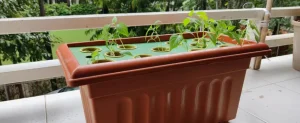
What is a Hydroponic System? Definition, types and everything you need to know
By Achint Kalra
Updated 07 Nov, 2024
12 min read
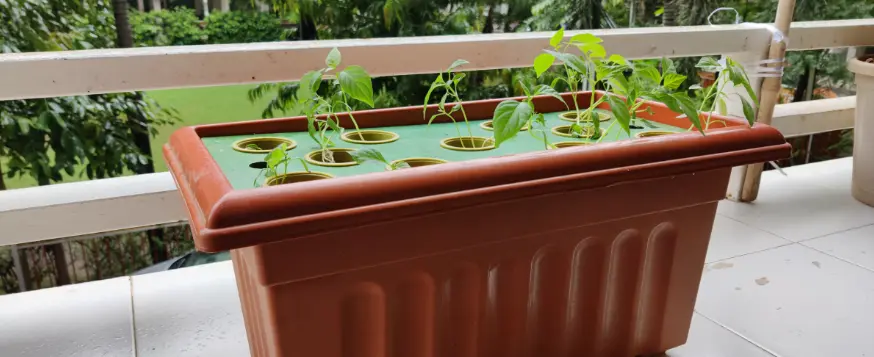
Contents
Hydroponic system, I reckon you’ve heard that term quite a few times. Especially if when you are eating salads. By definition- Hydroponics is the art of growing plants without soil. Yes, you heard it right. Also, it is very doable and can be the new way of growing plants in your home. Let’s understand all about it.
The definition of Hydroponics
Hydro translates to ‘water’ and ponos means ‘water working’. Also known as nutri-culture, aquaculture, soilless way or the tank method. Traditional way of growing plants requires about 50L of water per 10 plants. Whereas, it only takes 20L using the hydroponic system.
The history of Hydroponic system

To understand how Hydroponic system works, let’s get back to the history of how Hydroponics was invented:
Plant scientists started looking into plant illnesses in the 1930s, and in doing so, they noticed symptoms that were connected to existing soil issues like salinity. William Frederick Gericke of the University of California, Berkeley, first publicly advocated for the application of solution culture concepts to crop production in 1929.
Gericke used mineral fertilizer solutions rather than soil to produce tomato vines that were 25 feet (7.6 meters) high in his backyard. When W. A. Setchell, a phycologist, presented the term hydroponics to him in 1937, he used it for the first time.
Hydroponic system either uses sand or gravel and added nutrients to grow plants. You might wonder about the benefits of this new method. However to your surprise, it is really not that new. The Aztecs and the Chinese have been using Hydroponic system through the 10th and 13th centuries. However, being nameless back then, the Chinese used hydroponic system to grow rice on fields deprived of soil. It was only in the 20th century when the term ‘Hydroponics’ was coined.
Let’s see how hydroponic system is different from the traditional way of growing plants.
Hydroponic system v/s traditional methods
The term Hydroponics clearly indicates no use of soil, which is the basic structure of growing plants using a traditional method. Henceforth, better yield can only be expected if the soil is of a good quality. Opposite to the soil dependence, hydroponic system is completely dependent on the nutrients. It produces 35-50% better yield compared to traditional farming. This is only because the plant is directly infused with nutrients which ensures a better nutrient quality in the crop.
Hydroponic system is additionally quite simple to maintain. Once the setup is done, it requires no pesticides, manure, regular water or even the ever-blazing sun. This also implies that all additional expenditures associated with the conventional method of producing plants become null once you become adept in mastering hydroponics.
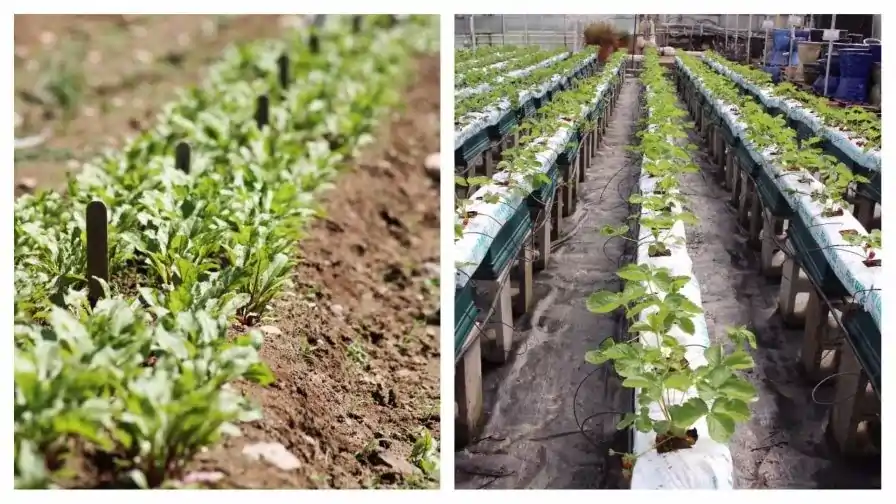
But let’s address the elephant in the room. Agriculture and traditional farming practices have significant carbon footprints. Despite the fact that plants absorb carbon dioxide and release oxygen, there is a huge discrepancy in the production methods. In terms of agricultural emissions, India is not further behind China. The degeneration of nutrient matter in the soil, farming techniques, crises like soil erosion, stubble burning, transportation of harvest are some of the reasons why.
In this scenario, Hydroponic system can be the torchbearer when it comes to achieving zero-carbon production. Since crops are exposed straight to water without the use of soil, hydroponic farming absorbs carbon from the atmosphere without damaging the land. Furthermore, Hydroponic farms can survive in urban settings or places where agricultural grounds are unsuitable for conventional techniques. This is because they can grow indoors with little space. Transportation issues and soil erosion are both resolved by such a technique.
Going net-zero is how we can prevent the climate crisis from taking over us. We are able to expand in that way by using carbon-neutral methods. As a result, we must use more renewable resources, avoid using non-renewable ones, and ensure that we leave the earth in better shape than when we found it.
Let’s see how we can use Hydroponic system in our daily lives. Read the story of the research scientist Harshit Dave who researched hydroponics and created a kit for individuals to grow and eat pesticide free food at home.
How to setup a Hydroponic system?
Hydroponics can come with its own set of jargons and techniques. But let’s break it down to its most original form. In a layman’s language, you grow lettuce and allow the roots of the lettuce to sit in water which is rich with nutrients. You allow the proper amount of light and ensure a great pH balance (which is not quite hard) and watch your plant bloom.
Again, what is Hydroponics? It is basically a water-based technique of growing plants in a controlled environment, where you can configure your variables aka the nutrients, sunlight and water.
To suit every environment and structure, there are different systems of using Hydroponics. All of the systems work in the same principles however are only different in ways of appliances, application and structure.
Types of Hydroponic systems
Hydroponics can be practiced with varied different techniques. I’ve list down the six types of methods which will help you grow food – the sustainable way. There are mainly 6 types of hydroponics systems used across various parts of the world.
1. Deep Water Culture (DWC)
By immersing the plant roots in a solution of nutritionally rich, oxygenated water, deep water culture (DWC) is a Hydroponic technique for growing plants. This approach, sometimes referred to as deep flow technique (DFT), floating raft technology (FRT), or raceway. This is because it makes use of a rectangular tank that is less than one foot deep. This tank is then filled with a nutrient-rich solution. The top of the tank has Styrofoam boards in which the plants are floating.
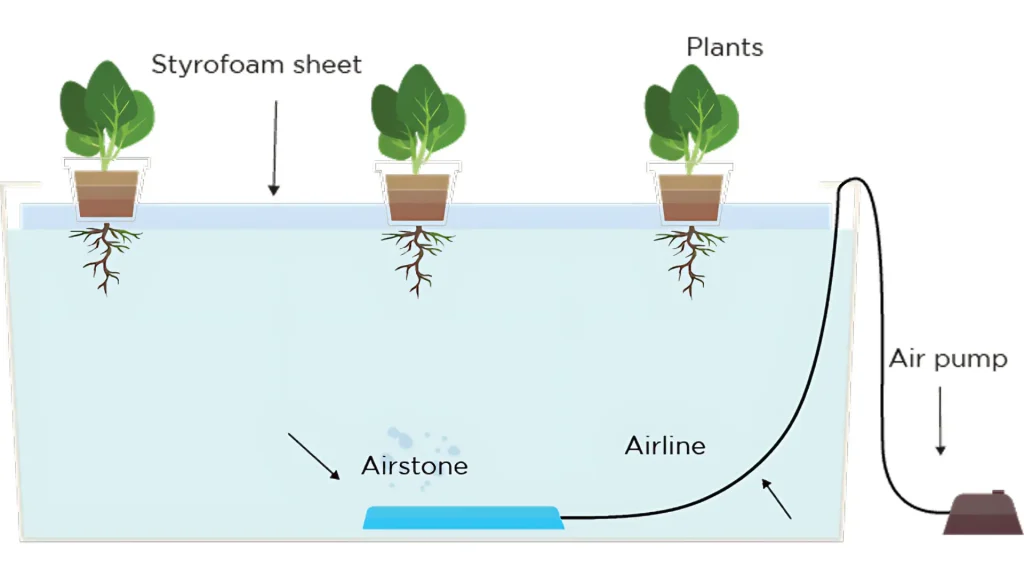
Key components of a DWC System:
- Reservoir: Holds the nutrient solution.
- Net Pots: Contain the plants and support their roots.
- Air Pump and Air Stones: Oxygenate the water to prevent root rot and support healthy root function.
- Nutrient Solution: A balanced mix of essential nutrients that the plants need for growth.
Plants suitable for DWC:
DWC is especially effective for fast-growing, water-loving plants. Here are some suitable options:
- Leafy Greens: Lettuce, spinach, kale, and arugula thrive in DWC due to their short growth cycles and relatively simple nutrient requirements.
- Herbs: Basil, mint, cilantro, parsley, and chives perform well in DWC systems, where they receive consistent moisture and nutrients.
- Fruiting Plants: Tomatoes, peppers, and cucumbers can be grown in DWC, though they may require a larger setup with more space for the root system and structural support.
- Flowering Plants: Certain flowers like chrysanthemums, marigolds, and petunias also adapt well to DWC.
Advantages of DWC:
- Faster growth rates due to constant access to water, nutrients, and oxygen.
- Minimal maintenance since roots don’t need to be watered frequently.
- Simple setup, making it beginner-friendly.
Considerations
- DWC systems require careful monitoring of water temperature (ideally between 65-75°F) and pH (typically 5.5-6.5).
- Regularly check the nutrient levels and oxygenation to avoid root rot and nutrient deficiencies.
DWC is an excellent method for beginners in hydroponics, especially for leafy greens and herbs, as it offers a stable environment for root development and growth.
2. Nutrient Film Technique (NFT)
Let’s understand the process of NFT. It contains a pretty shallow stream of water containing all the nutrients needed for plant growth. This water is pumped past the exposed roots of plants in a waterproof trench, also known as channels. The roots of the plants are exposed to sufficient amounts of water, oxygen, and nutrients. This whole process of the hydroponic technique is called nutrient film technique (NFT).
One has to make sure to use the appropriate channel slope, flow rate, and length. This decides the foundation of a properly constructed NFT system.
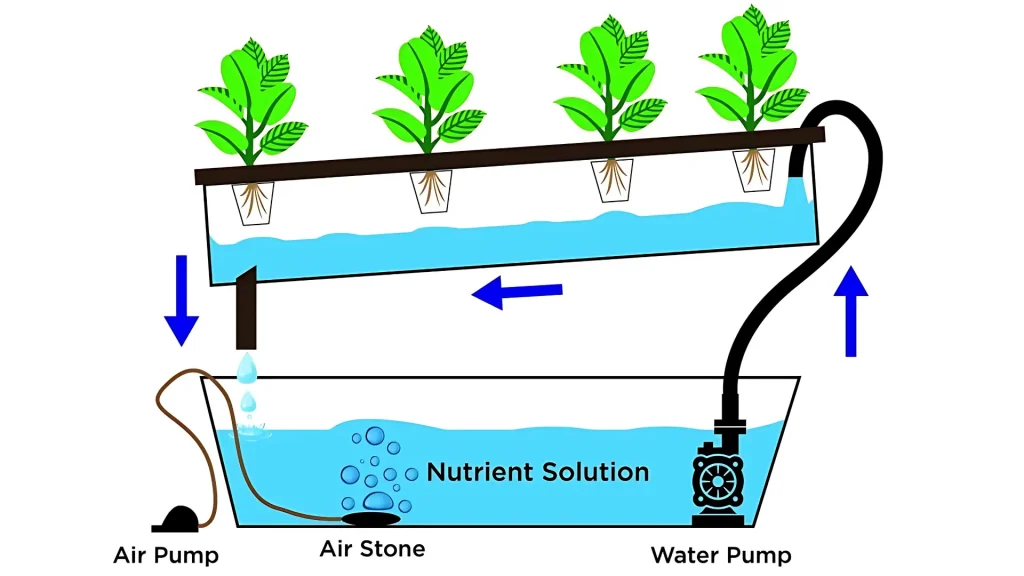
Key components of an NFT System:
- Growing Channels: Slightly sloped channels where plant roots can access the nutrient solution.
- Reservoir: Holds the nutrient solution and supplies it to the growing channels.
- Pump: Delivers nutrient solution from the reservoir to the channels, ensuring a constant flow.
- Return System: Allows the unused solution to flow back into the reservoir, creating a closed-loop system.
Plants suitable for NFT:
NFT systems are best suited for lightweight, fast-growing plants with smaller root systems, as large plants can block water flow or require more root space than the channels provide.
- Leafy Greens: Lettuce, spinach, and arugula grow very well in NFT systems due to their shallow roots and high nutrient uptake.
- Herbs: Basil, mint, oregano, and thyme are well-suited to NFT because they have compact root structures and benefit from the consistent nutrient access.
- Strawberries: Often grown in NFT, strawberries benefit from the system’s continuous flow and nutrient availability, though they need extra care to avoid waterlogging.
Advantages of NFT:
- Plants receive a continuous flow of nutrients, promoting faster growth and higher yields.
- Reduced nutrient and water waste, as the system recirculates unused solution.
- Great for high-density setups and stacking systems, as it allows vertical growth in limited spaces.
Considerations:
- NFT systems require careful monitoring of water flow, as any pump failure can quickly cause roots to dry out due to minimal water retention.
- It’s essential to monitor for blockages in the channels, as nutrient flow is critical to plant health.
- Maintaining the right slope is important to prevent pooling and ensure an even nutrient flow along the channel.
NFT is a highly efficient hydroponic technique, particularly suited for smaller, fast-growing plants that don’t need much root space. It’s commonly used in commercial hydroponics due to its high yield potential and space efficiency.
3. Aeroponics
Aeroponics is the process of growing plants in air or mist. This does not involve any foreign substrate or medium. By sprinkling a nutrient-rich water solution onto the plant’s lower stem and suspended roots, the primary idea behind aeroponic growing is to grow plants dangling in an enclosed or semi-closed atmosphere.
The plant support structure separates the plant’s roots. To reduce labour and costs, closed-cell foam is frequently squeezed around the lower stem and placed into an aperture in the aeroponic chamber.
For larger plants, trellising is employed to sustain the weight of the foliage and fruit.
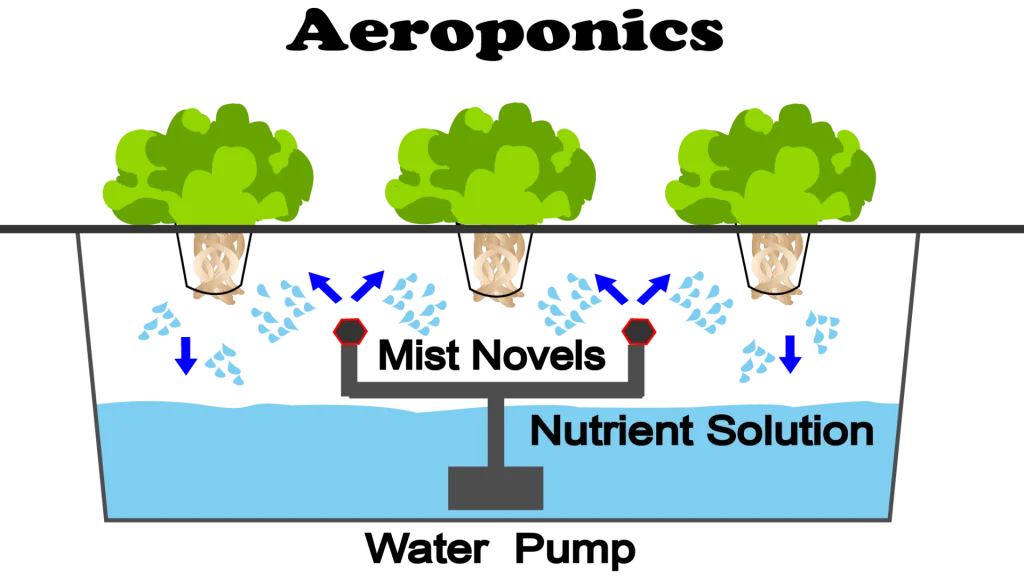
Key components of an Aeroponics system:
- Root Chamber: A closed, dark space where plant roots are suspended, ensuring they receive only mist and remain isolated from light to prevent algae growth.
- Misting System: Delivers a fine mist of nutrient solution to the roots at regular intervals. This can be managed through timed pumps that create the mist.
- Reservoir: Stores the nutrient solution that will be misted onto the roots.
- Pump and Nozzles: Essential for creating and distributing the nutrient mist throughout the chamber.
Plants suitable for Aeroponics:
Aeroponics is ideal for plants that benefit from high oxygen levels at the root zone and are well-suited for more delicate root management. It’s commonly used for both leafy greens and fruiting plants.
- Leafy Greens: Lettuce, kale, arugula, and spinach thrive in aeroponic systems, as they have relatively shallow root systems and benefit from the high oxygen exposure.
- Herbs: Basil, thyme, oregano, and mint are ideal for aeroponics, as their compact root structures adapt well to misting and offer a high yield in small spaces.
- Fruiting Plants: Tomatoes, cucumbers, and strawberries can be successfully grown in aeroponics, although they may require larger systems and careful monitoring to ensure proper nutrient access.
- Root Vegetables: While more challenging, certain root vegetables like radishes and carrots can be grown aeroponically if conditions are carefully controlled.
Advantages of Aeroponics:
- Maximum Oxygen Exposure: Roots receive high levels of oxygen, which can lead to faster growth and increased nutrient uptake.
- Water and Nutrient Efficiency: The misting system delivers precise amounts of water and nutrients directly to the roots, reducing waste.
- Space Efficiency: Aeroponics is well-suited for vertical systems and stacking, making it ideal for high-density growing in small areas.
Considerations:
- System Reliability: Aeroponics requires reliable pumps and misting nozzles; any equipment failure can lead to rapid root dehydration, as there is no water reservoir to keep roots moist.
- Fine-Tuned Environment: Temperature, humidity, and misting intervals must be closely managed to maintain optimal growth conditions.
- Regular Maintenance: The misting nozzles can become clogged due to mineral buildup, so regular maintenance is essential for smooth operation.
Aeroponics is a highly efficient, space-saving system ideal for growing a wide range of plants, particularly in urban or high-density environments. However, it requires careful management and maintenance, making it more suitable for experienced growers or those willing to invest in automation.
4. EBB and flow system
One of the most well-known hydroponics systems is ebb and flow, sometimes referred to as flood and drain.
The adaptable system may be set up for a reasonable price and only requires maintenance expertise at the intermediate level. The basic idea is similar to other techniques in that crops are positioned in a dish, which is routinely supplied with water pumped out of a tank below that is rich with nutrients. The water is returned to the tank by the mechanism using gravity so it can be used again.
A submersible pump that is linked to a timer is typically used for this operation.
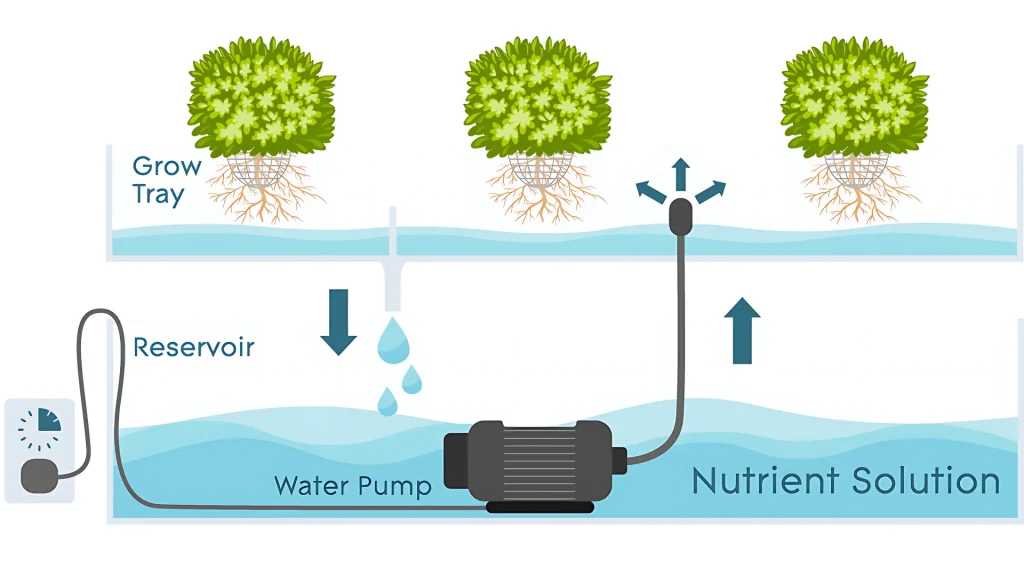
Key components of an Ebb and Flow system:
- Growing Tray: Holds the plants and the medium, which can include materials like rockwool, clay pebbles, or coco coir.
- Reservoir: Stores the nutrient solution and is connected to the growing tray via a pump and drain system.
- Pump and Timer: The pump, controlled by a timer, floods the tray with nutrient solution at set intervals. When the timer turns off, the solution drains back into the reservoir.
- Overflow Drain: Prevents the growing tray from overfilling and ensures excess solution returns to the reservoir.
Plants suitable for Ebb and Flow system:
Ebb and Flow systems can support a wide range of plants, especially those with larger root systems. It’s also well-suited for plants with varying water needs, as the flooding intervals can be adjusted.
- Leafy Greens: Lettuce, spinach, arugula, and kale grow well in Ebb and Flow systems due to their shallow root requirements and relatively quick growth cycles.
- Herbs: Basil, mint, chives, and parsley are ideal, as they can tolerate periods of nutrient exposure followed by drainage.
- Fruiting Plants: Tomatoes, peppers, strawberries, and cucumbers can be grown in Ebb and Flow systems, though they may need more frequent flood cycles and additional support as they grow.
- Root Vegetables: Plants like carrots, radishes, and beets can also thrive, as the flooding and draining cycles create a stable, oxygenated environment for root development.
Advantages of Ebb and Flow system:
- Flexible Flooding Intervals: The ability to control flood frequency allows for customization based on plant needs, making it adaptable for many plant types.
- Efficient Nutrient Use: The system recycles nutrient solution, reducing waste and allowing for easy adjustments.
- Less Risk of Root Rot: The draining process ensures roots receive oxygen and helps prevent rot, a common issue in continuous submersion systems.
Considerations:
- Timer Reliability: A timer failure can prevent the flooding or draining cycles, which could lead to dry roots or waterlogged plants.
- Regular Maintenance: The pump and tray require periodic cleaning to prevent clogging and ensure smooth operation.
- Medium Choice: The growing medium should be able to retain moisture but allow drainage, as excessive retention can lead to oversaturation and root problems.
The Ebb and Flow technique is highly effective for growers looking for versatility and control over the growing process. It’s ideal for larger plants and works well for those wanting a setup that can accommodate a wide variety of plants.
5. Wicking
The most fundamental type of hydroponics is a wick system, which is relatively simple to put up. Quickly growing lettuce or herbs are the finest plants to utilize in this arrangement. This system demonstrates fewer moving parts. It doesn’t call for highly complex machinery or apparatus, such as motors and pumps, or extraordinary technical accomplishments.
A wick system is therefore quite simple and basic in relation to active systems like ebb and flow or drip systems. Capillary action serves as the foundation for the wick system’s operation. This is a typical, natural occurrence associated with water flowing through sealed tubes.
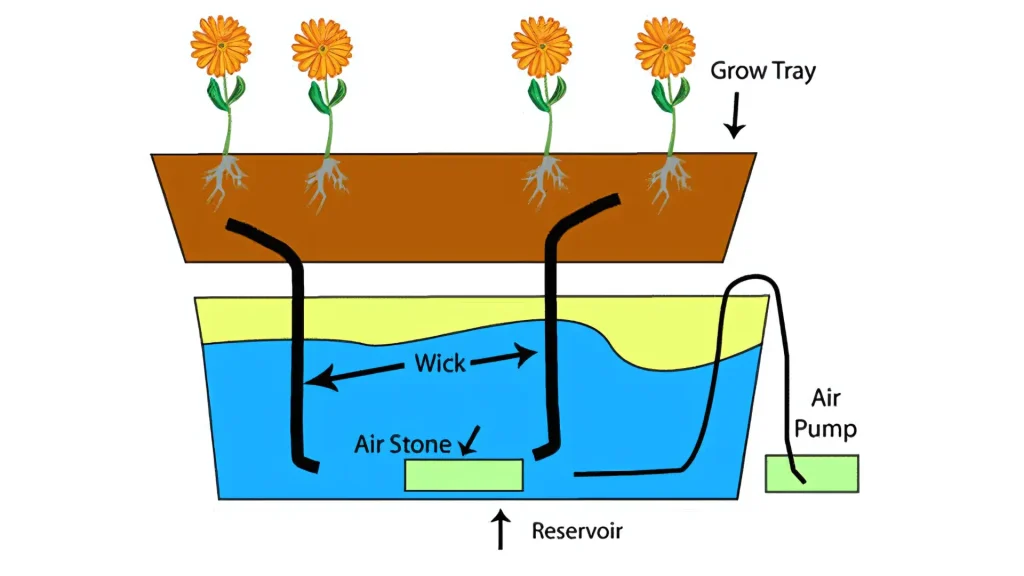
Key components of the Wicking system
- Growing Medium: Holds the plants and must have good moisture retention, such as coco coir, perlite, or vermiculite.
- Reservoir: Contains the nutrient solution that the wick draws up to feed the plants.
- Wick: Usually made from absorbent material like cotton, felt, or nylon, it transfers the nutrient solution from the reservoir to the growing medium.
- Support Structure: Keeps the growing medium and plants stable above the reservoir.
Plants suitable for the Wicking system:
Wicking is best suited for smaller plants and those with low to moderate water needs, as it may not deliver enough solution for high-demand or large plants.
- Leafy Greens: Lettuce, spinach, and arugula perform well in wicking systems due to their low nutrient and water needs.
- Herbs: Basil, thyme, mint, and oregano are ideal, as they can thrive with a consistent but modest water supply.
- Small Houseplants: Houseplants like pothos, peace lilies, and some succulents do well with wicking, as they require moderate, steady moisture.
Advantages of the Wicking system:
- Low Maintenance: Wicking systems require minimal maintenance, as there are no moving parts, pumps, or timers to monitor.
- No Electricity Needed: Since it’s a passive system, there’s no need for electricity, making it a cost-effective and environmentally friendly option.
- Simple Setup: Easy to construct and ideal for beginners, with very few materials required.
Considerations:
- Limited to Small Plants: Larger or fast-growing plants typically need more water and nutrients than a wicking system can provide.
- Medium Choice is Crucial: The growing medium must retain enough moisture for the plant’s needs without becoming overly saturated, as this can lead to root rot.
- Regular Nutrient Monitoring: Nutrient levels need to be checked periodically, as passive systems can lead to nutrient imbalances over time.
Wicking is an excellent, low-cost hydroponic method, particularly suitable for small, water-efficient plants. Its simplicity and low-maintenance nature make it ideal for home growers or beginners looking to try hydroponics without significant investment.
6. Drip system:
One of the most commonly heard systems of irrigation is the drip system. Of all hydroponic systems, drip systems are the most widely used. In drip hydroponic system, drip irrigation is used to supply the water-based nutrition mixture to the root zone of the plants.
This type of Hydroponics adapts the most water-efficient irrigation method used in conventional horticulture to a growing system without soil. By slowly dripping moisture onto the roots of the plants rather than simulating precipitation from above, this kind of low volume treatment prevents water loss through evaporation.
Now that we know about the various systems in short, the main question arises whether hydroponics can help us achieve net-zero carbon?
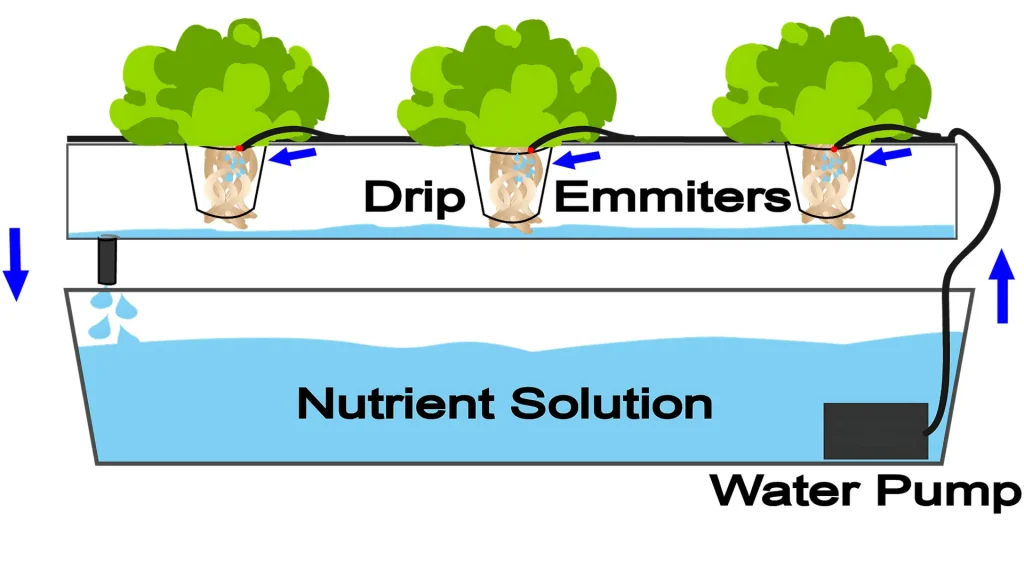
Key Components of a Drip System:
- Drip Emitters: Control the flow of nutrient solution to each plant, ensuring even distribution.
- Growing Medium: Holds the plants and retains moisture, with options like rockwool, perlite, or coco coir.
- Reservoir: Stores the nutrient solution and supplies it to the emitters via a pump.
- Pump and Timer: The pump delivers the solution through the emitters, and a timer controls the intervals, allowing for precision in watering frequency.
- Drainage System (Optional): In a recirculating system, excess solution drains back to the reservoir; in a non-recirculating system, it’s drained away after use.
Plants suitable for Drip systems:
Drip systems are adaptable and can support a wide variety of plants, from leafy greens to fruiting and flowering species. The adjustable drip rate makes them suitable for plants with different moisture needs.
- Leafy Greens: Lettuce, spinach, kale, and arugula thrive with a drip system due to their relatively low water requirements.
- Herbs: Basil, thyme, parsley, and chives grow well, as they benefit from the steady moisture provided by the drip system.
- Fruiting Plants: Tomatoes, peppers, cucumbers, and strawberries are commonly grown in drip systems, as they require higher nutrient levels and can be easily supported with adjustable flow rates.
- Flowering Plants: Flowers like marigolds, petunias, and chrysanthemums perform well, as they need consistent, moderate watering that can be controlled with drip emitters.
Advantages of the Drip system:
- Adjustable Flow Rate: The ability to customize water flow makes it adaptable to a wide range of plant species.
- Efficient Water Use: Recirculating systems conserve water by reusing excess solution, making it eco-friendly.
- Easy to Scale: Drip systems can be easily expanded, making them suitable for both small and large-scale operations.
Considerations:
- Emitter Maintenance: Emitters can become clogged, especially if mineral buildup occurs, so regular cleaning is essential for consistent performance.
- Timer Reliability: Since the system relies on timed intervals, any timer failure can lead to over- or underwatering.
- Risk of Root Drying: In non-recirculating setups, plants can dry out if the pump fails, as the nutrient solution isn’t stored around the roots.
Drip systems are one of the most flexible and efficient hydroponic methods, ideal for a wide range of plants and growing conditions. Their ability to provide precise watering and nutrient delivery makes them popular among both beginner and advanced growers, particularly for large-scale or commercial operations.
Can hydroponic systems help us achieve net-carbon zero?
The balance between the amount of carbon gas released and the amount taken from the atmosphere is known as net-zero carbon. Additionally, the word “carbon” is used to refer to all of the greenhouse gases that lead to global warming.
The phrase “carbon footprint” may be familiar to you. The amount of carbon dioxide released into the atmosphere as a result of a specific person’s, group’s, or community’s activity is described as their “carbon footprint” in the dictionary.
Eating vegan food, taking the bus to work or even electric vehicles allow you to reduce your carbon footprint. So, yes. Using hydroponics to grow your own produce is a very big step in ensuring net-carbon zero at your home.
As discussed previously, hydroponic system leads to lesser emissions and less pollution thereby proving to be better than the traditional methods of farming. WWF devised a calculator to estimate what your carbon footprint is. According to researches, food accounts for 10-30% of a household’s carbon footprint, typically a higher portion in lower-income households. Production accounts for 68% of food emissions, while transportation accounts for 5%. Thereby, improving the methods of producing and making food will cut down your carbon footprint and help you get one step closer towards a net-zero carbon home.
Amount of carbon absorbed by common houseplants in 24 hours. (source) This research also proved that 30 prayer-plants have the capacity to offset the carbon emission from charging your phone in 24 hours.
However, setting up a hydroponic system is not the only way it can happen. One has to make sure to be aware of his carbon footprint and make sustainable lifestyle choices. Like the SMU-X net zero energy building already working in Singapore, several other projects are building around the same concept. The process of going net-zero carbon is holistic and so must be the education and awareness behind it.

